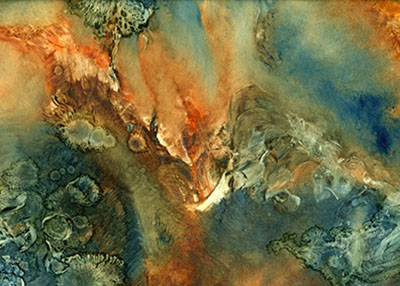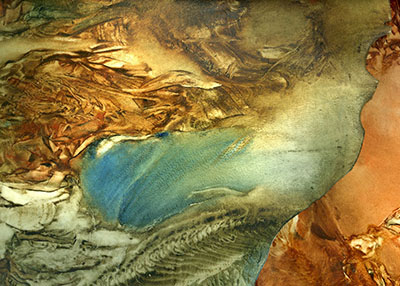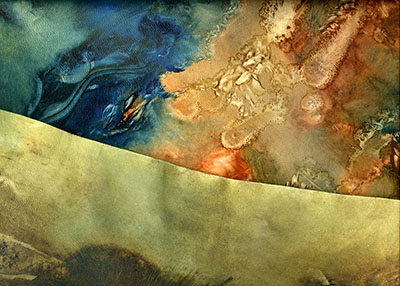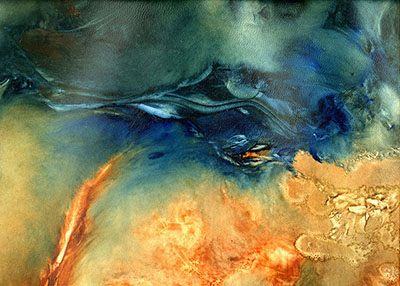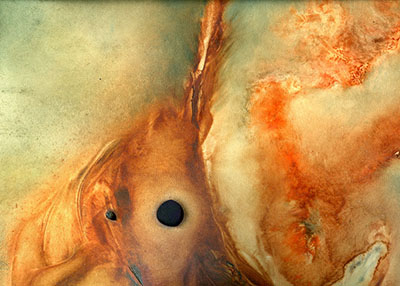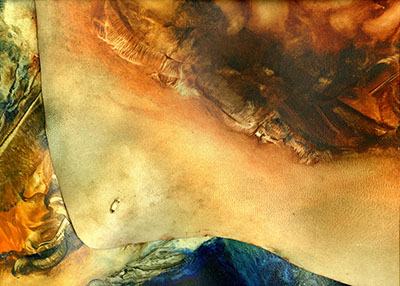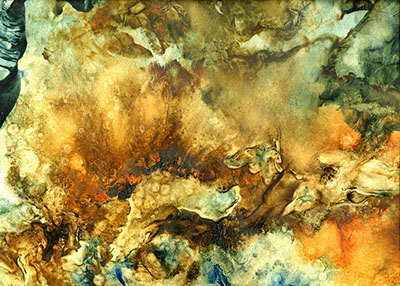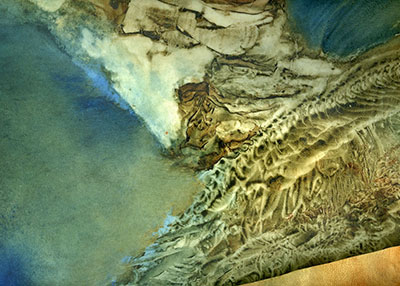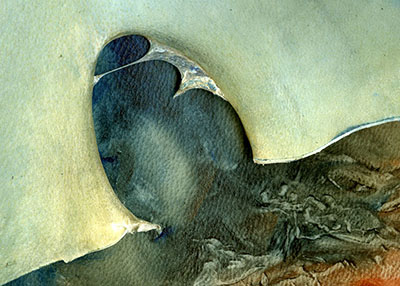 
|
 |

 
|

Dibujos/Drawings
Paisajes/Landscapes
Codex Libros de artista/ Artist's books
Artefactos/Artifacts |
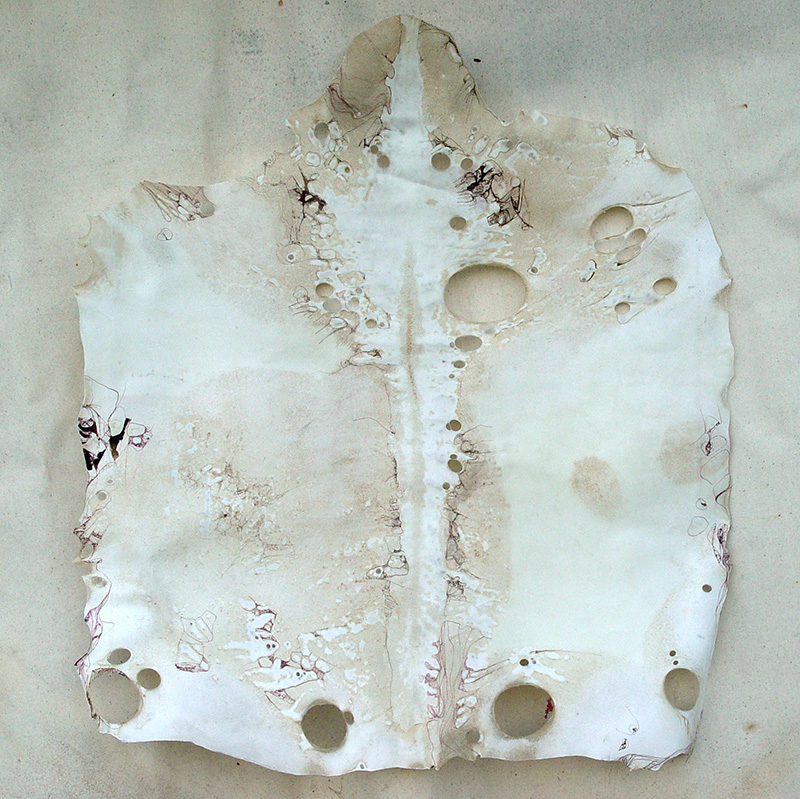
Códice del Alba
|
 |
|
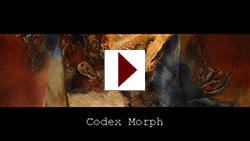
|
La Piel
Mi búsqueda como artista ha sido desde el comienzo un viaje hacia la existencia. A través de la exploración de los paisajes he ido a lo profundo de mis propias raices.
La curiosidad por conocer lugares salvajes y el impulso de la aventura me llevó a las selvas y ríos de América del Sur. El viaje se convirtió en experiencia permanente cuando construí una cabaña en la selva amazónica y me sumergí en el fluir salvaje de la vida tropical. Ahí, más allá del sonido interminable de las creaturas del bosque, empezé a escuchar el susurro del lugar. Mis sentidos, mi existencia, empezaron a resonar con el pulso de la tierra.
Crecimiento y transformación, sedimentación y erosión: el fluir de la materia y el tiempo es lo que labra los lugares, las creaturas y las cosas, así como mi diálogo con lo natural. Cuadernos de bitácora, códices y mapas -hechos de cortezas de árboles, papeles artesanales, pergaminos y cueros- son instrumentos de navegación y crónicas de viaje, cartografías de lo efímero y lo eterno, de silencios y vacíos.
La Piel trata de la fragilidad como característica primaria de la tierra viviente, ese delgado tejido de vida que crece de lo mineral, del aire, del agua y la luz. Trata de su fragilidad y resiliemcia, metáfora de nuestra propia existencia.
Trata del fluir interminable de la vida: un solo organismo en constante metamorfosis.
Trata de nuestro diálogo sagrado con el paisaje y sus seres, de la transformación de lo natural a lo cultural, reconociendo así nuestros origenes.
Y trata de la liviandad, ese estado del ser que comparte la misma sustancia con los sueños.

Códice del viento
Skin
My journey as an artist has been since the beginning a journey into existence:
Through the exploration of landscapes I have gone deep into my own roots.
A curiosity to know wild places and a drive for adventure took me into the forests and rivers of South America. The travel became a permanent experience when I built a cabin in the Amazon jungle and submerged myself into the wild flow of tropical life. There, beyond the endless sound of the creatures of the forest, I started to listen to the whisper of the land. My senses, my body, my existence, tuned to the beat of the earth.
Growth and transformation, sedimentation and erosion: the flow of matter and time is the carver of places, creatures and thinks, as well as the art that flows from my dialog with nature. Images, books, journals, maps and objects assembled along this journey are the testimonies of change and transience, as well as navigation devises.
Skin is about fragility as a primary feature of living matter.
Is about the skin of the earth, thin layer of life that grows from mineral, air, water and light. It's about its fragility and endurance, a metaphor of our own individual existences. It's about the endless flow of life, its constant metamorphosis from organism to organism. It's about our sacred dialogue with the landscape and its beings: it's about the transformation of nature into culture, and in doing so, the recognition of our origins. It's about lightness, the state of being that has the same substance of dreams.
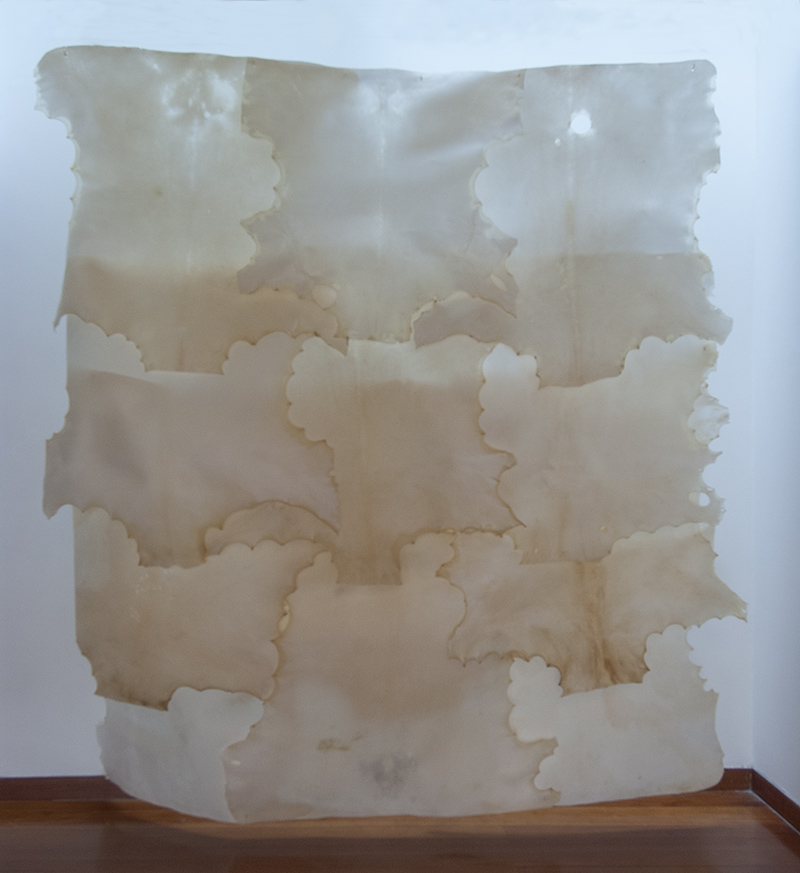
Códice de la Luna

Códice Aarash

|
|
Codex Morph
|

|
| |

Diego Samper, a Columbian who now lives in British Columbia, has chosen the tangible subject of skin for his first show at Toronto's DeLeon White Gallery. The exhibit uses skin as a metaphor for the physical body and likewise the earth's skin. Some of his works look like living tissue themselves, as their borders are less defined, and their content/subjects
are textural, with a variety of constituent parts including ink, beeswax, and the like. Referred to as the Codex works these hand made parchmentpieces include mineral, oil, and drawings. Near abstract, they are like maps with shapes that look animal or human within them. The Codex works at DeLeon White Gallery, are made of parchment, used since ancient times to documentthe human experience. Its skin-like quality makes it a stable medium for commemorating the soul's journey, the myths and deeds of humans and gods.
The Codex series are made over goat skins. Nature provides the support for a human reflection on our place in nature, both in the microcosm and the macrocosm. They have layers, strata, and like skin, they are an epidermis.
The vegetal and mineral co-mingle in the surface of these works, and permutate, change, transform, even decay eventually.
Samper, who lived rough in the Amazon jungle, published a superb book of photographs of this experience titled Las Voces de la Terra. With a forward by William Ospina, this book again presents images of the natural, physical world. Samper's Codex parchment works, like his photographs
(published in National Geographic and the book Makuna, portrait of an Amazonian culture published by The Smithsonian) reflect a sense of belonging to the earth, that it is our home. The identification with earth becomes a universal metaphor, a vehicle for presenting these emblems of spiritual renewal, the Codexes. The allusion to mapping could just as easily have to do with biological coding, genetic mapping. The surfaces of his Codexes can also resemble territories, as if seen afar.
When viewers look into the container/vessel Samper has made for the show at DeLeon White, they are surprised at its contents. Life here is presented as a fragile vessel - hand made of parchment - in the centre of the exhibition. This container is filled with red seeds collected in the Amazon region of South America. The seeds inside are not shocking, not violent, nor avant garde, nor dangerous. They are simply there - rich and red and lustrous. The container is light and at odds with its apparent size. The lightness of the vessel is a metaphor for air and light, our life support systems, and the fragility of life.
An actual section of ficus tree bark from South America extends across a gallery wall. An artist's book has been placed under the tree bark.
Parchment pieces hang from the ceiling, and float in space like illusions.They are very much like ritual objects. The titles like Codex Pulowi, Codex Aarash, Codex Amazonica, are ascribed to the art before it is made, and they reference sacred sites and nature spirits' names. For Samper the parchments are "an offering to the spirits of the Earth, and a transmutation of the animal into a cultural artifact".
John K. Grande
Vie des Arts #194 printemps 2004
|

|
| |
Morph, instalation. Tieton, Washington, USA, 2007
Skin, DeLeon White Gallery, Toronto, Canada, 2004
Log Books and other dreams, Gallery Route One, Point Reyes, California,USA, 2003 . |
|
| Cero Galería, Bogotá, 2008 |
|
|

|

|
  |
|
| |
|
|







